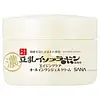What's inside
What's inside
 Key Ingredients
Key Ingredients

 Benefits
Benefits

 Concerns
Concerns

No concerns
 Ingredients Side-by-side
Ingredients Side-by-side

Water
Skin ConditioningGlycerin
HumectantCaprylic/Capric Triglyceride
MaskingDipropylene Glycol
HumectantHydrogenated Poly(C6-12 Olefin)
Skin ConditioningPentylene Glycol
Skin ConditioningPPG-10 Methyl Glucose Ether
Skin ConditioningBehenyl Alcohol
EmollientButylene Glycol
HumectantCaprylhydroxamic Acid
Carbomer
Emulsion StabilisingDimethicone
EmollientDisodium EDTA
Glyceryl Stearate
EmollientHydrolyzed Hyaluronic Acid
HumectantLactococcus/Hyaluronic Acid Ferment Filtrate
PEG-6
HumectantPEG-32
HumectantPEG-20 Sorbitan Isostearate
EmulsifyingPhytosteryl/Octyldodecyl Lauroyl Glutamate
Skin ConditioningPropanediol
SolventSodium Acetylated Hyaluronate
HumectantSodium Hyaluronate
HumectantStearyl Alcohol
EmollientTriethanolamine
BufferingWater, Glycerin, Caprylic/Capric Triglyceride, Dipropylene Glycol, Hydrogenated Poly(C6-12 Olefin), Pentylene Glycol, PPG-10 Methyl Glucose Ether, Behenyl Alcohol, Butylene Glycol, Caprylhydroxamic Acid, Carbomer, Dimethicone, Disodium EDTA, Glyceryl Stearate, Hydrolyzed Hyaluronic Acid, Lactococcus/Hyaluronic Acid Ferment Filtrate, PEG-6, PEG-32, PEG-20 Sorbitan Isostearate, Phytosteryl/Octyldodecyl Lauroyl Glutamate, Propanediol, Sodium Acetylated Hyaluronate, Sodium Hyaluronate, Stearyl Alcohol, Triethanolamine
Water
Skin ConditioningGlycerin
HumectantButylene Glycol
HumectantAlcohol Denat.
AntimicrobialCyclopentasiloxane
EmollientCetyl Ethylhexanoate
EmollientHydrogenated Castor Oil Stearate
Skin ConditioningMilk Ferment
Skin ConditioningGlycine Max Seed Extract
Skin ConditioningSoy Protein Phthalate
EmollientRetinol
Skin ConditioningSoy Isoflavones
Skin ConditioningRetinyl Palmitate
Skin ConditioningCeramide Ng
Skin ConditioningVinyl Dimethicone/Methicone Silsesquioxane Crosspolymer
PEG-40 Hydrogenated Castor Oil
EmulsifyingPEG-60 Hydrogenated Castor Oil
EmulsifyingSodium Ascorbate
AntioxidantArginine
MaskingCarbomer
Emulsion StabilisingGlycyrrhiza Glabra Root Extract
BleachingDimethiconol
EmollientSqualane
EmollientStearic Acid
CleansingGlyceryl Stearate
EmollientSodium Stearoyl Glutamate
CleansingCetearyl Alcohol
EmollientPhytosterols
Skin ConditioningTocopherol
AntioxidantCaprylic/Capric Triglyceride
MaskingSodium Polyacrylate
AbsorbentPolysorbate 80
EmulsifyingLecithin
EmollientPotassium Hydroxide
BufferingHydrogenated Lecithin
EmulsifyingPhenoxyethanol
PreservativeWater, Glycerin, Butylene Glycol, Alcohol Denat., Cyclopentasiloxane, Cetyl Ethylhexanoate, Hydrogenated Castor Oil Stearate, Milk Ferment, Glycine Max Seed Extract, Soy Protein Phthalate, Retinol, Soy Isoflavones, Retinyl Palmitate, Ceramide Ng, Vinyl Dimethicone/Methicone Silsesquioxane Crosspolymer, PEG-40 Hydrogenated Castor Oil, PEG-60 Hydrogenated Castor Oil, Sodium Ascorbate, Arginine, Carbomer, Glycyrrhiza Glabra Root Extract, Dimethiconol, Squalane, Stearic Acid, Glyceryl Stearate, Sodium Stearoyl Glutamate, Cetearyl Alcohol, Phytosterols, Tocopherol, Caprylic/Capric Triglyceride, Sodium Polyacrylate, Polysorbate 80, Lecithin, Potassium Hydroxide, Hydrogenated Lecithin, Phenoxyethanol
 Reviews
Reviews

Ingredients Explained
These ingredients are found in both products.
Ingredients higher up in an ingredient list are typically present in a larger amount.
Butylene Glycol (or BG) is used within cosmetic products for a few different reasons:
Overall, Butylene Glycol is a safe and well-rounded ingredient that works well with other ingredients.
Though this ingredient works well with most skin types, some people with sensitive skin may experience a reaction such as allergic rashes, closed comedones, or itchiness.
Learn more about Butylene GlycolThis ingredient is an emollient, solvent, and texture enhancer. It is considered a skin-softener by helping the skin prevent moisture loss.
It helps thicken a product's formula and makes it easier to spread by dissolving clumping compounds.
Caprylic Triglyceride is made by combining glycerin with coconut oil, forming a clear liquid.
While there is an assumption Caprylic Triglyceride can clog pores due to it being derived from coconut oil, there is no research supporting this.
Learn more about Caprylic/Capric TriglycerideCarbomer is a polymer of acrylic acid. Its main role is to create a gel consistency.
A high amount of carbomer can cause pilling or balling up of products. Don't worry, most products contain 1% or less of carbomer.
Glycerin is already naturally found in your skin. It helps moisturize and protect your skin.
A study from 2016 found glycerin to be more effective as a humectant than AHAs and hyaluronic acid.
As a humectant, it helps the skin stay hydrated by pulling moisture to your skin. The low molecular weight of glycerin allows it to pull moisture into the deeper layers of your skin.
Hydrated skin improves your skin barrier; Your skin barrier helps protect against irritants and bacteria.
Glycerin has also been found to have antimicrobial and antiviral properties. Due to these properties, glycerin is often used in wound and burn treatments.
In cosmetics, glycerin is usually derived from plants such as soybean or palm. However, it can also be sourced from animals, such as tallow or animal fat.
This ingredient is organic, colorless, odorless, and non-toxic.
Glycerin is the name for this ingredient in American English. British English uses Glycerol/Glycerine.
Learn more about GlycerinGlyceryl Stearate is a mix of glycerin and stearic acid.
It is used to stabilize the mixing of water and oil ingredients. By preventing these ingredients from separating, it can help elongate shelf life. It can also help thicken the product's texture.
As an emollient, it helps soften skin and supports barrier-replenishing ingredients.
In cosmetics, Glyceryl Stearate is often made from vegetable oils or synthetically produced.
This ingredient may not be fungal-acne safe
Fun fact: The human body also creates Glyceryl Stearate naturally.
Learn more about Glyceryl StearateWater. It's the most common cosmetic ingredient of all. You'll usually see it at the top of ingredient lists, meaning that it makes up the largest part of the product.
So why is it so popular? Water most often acts as a solvent - this means that it helps dissolve other ingredients into the formulation.
You'll also recognize water as that liquid we all need to stay alive. If you see this, drink a glass of water. Stay hydrated!
Learn more about Water